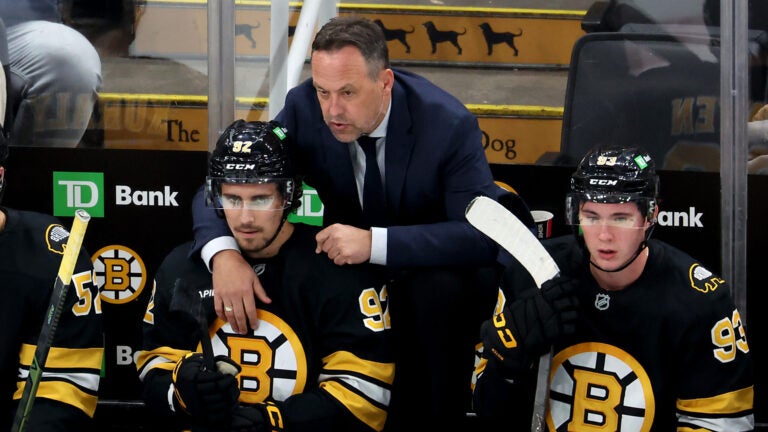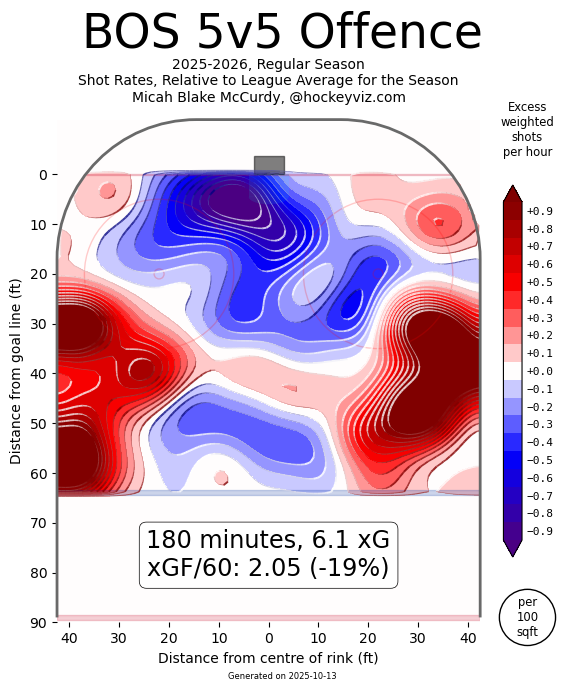Boston Bruins
Only three skaters on the Bruins’ roster have yet to record a point through the team’s first four games.

Marco Sturm’s efforts of molding the 2025-26 Bruins into a hard-working, straight-line squad has yielded strong returns out of the gate this year.
While many Bruins fans have spent most of the fall perusing through Gavin McKenna highlights, Boston has jumped out to a 3-1-0 record to open the year — buoyed by both expected production from the team’s franchise pillars, as well as several other contributors further down the depth chart.
Boston’s first true test will come on the road this week, as the Bruins are set to battle the Golden Knights, Avalanche, and Mammoth in the span of a four-night gauntlet out West.
Still, the Bruins have showcased some signs in the early going that this group could be more competitive than many might have expected.
Here’s what has caught our eye through the first week of Bruins action.
100%: Boston’s penalty kill percentage
If the Bruins want to shift their fortunes after a disastrous 2024-25 campaign, fixing the team’s woeful special-teams play stood as one of the top priorities for Marco Sturm and his staff.
So far, Boston’s shorthanded unit has been up to the task — opening the year with a perfect 14-for-14 showing in PK opportunities. It’s been a welcome sight after last year’s PK — usually a stout grouping on Boston’s roster — dropped to 24th in the league with a 76.3 percent success rate.
Perhaps the most encouraging development for Boston on the PK is the number of new faces who have fit seamlessly into that unit.
After Boston lost three shorthanded stalwarts during their roster teardown in March between Brad Marchand, Charlie Coyle, and Brandon Carlo, offseason additions like Sean Kuraly (3:00 shorthanded TOI per game), Fraser Minten (2:17), and Tanner Jeannot (2:04) have impressed.
Both Andrew Peeke (3:27 SH TOI per game) and Pavel Zacha (2:22) have also thrived under added minutes on the PK as well, further ingratiating themselves to Sturm as dependable options under those taxing shifts.
3: The number of Bruins skaters who haven’t recorded a point
For all of the talk of the Bruins’ offense being barren beyond the top line of David Pastrnak, Elias Lindholm, and Morgan Geekie, Boston has managed to spread the wealth in the scoring department thorough its first four games.
So far, only three skaters on Boston’s roster have yet to land on the scoresheet: Hampus Lindholm, Marat Khusnutdinov, and Mason Lohrei.
Lindholm has also only logged 24:27 of total ice time this year before leaving Thursday’s home opener with a lower-body injury, while Khusnutdinov is averaging a little over 10 minutes of ice time per game as a fourth-line winger.
Even though an offensively-gifted D in Lohrei has yet to record a point, he’s had his chances. According to Natural Stat Trick, Lohrei ranks 18th out of 194 eligible defenseman (min. 25 minutes played) in expected goals this season at 0.54.
Boston’s varied avenues of offense may not be sustainable, but it’s been a pleasant surprise out of the gate for Sturm.
3.9: Jeremy Swayman’s goals saved above expected rate
As Jeremy Swayman goes, so goes the 2025-26 Bruins.
As such, it should come as little surprise that Boston is off to a strong start with Swayman looking poised and confident between the pipes.
Through two games, Swayman is sporting a .966 save percentage, while his goals saved above expected rate of 3.9 ranks fifth among NHL goalies (per MoneyPuck).
For those keeping tabs, Swayman’s goals saved above expected rate last season was a dreadful -9.1, tied for the 10th-lowest mark among qualified netminders.
And, as noted by 98.5 The Sports Hub’s Ty Anderson, this is the first time that Swayman has posted save percentages of .950 or higher in back-to-back games since stonewalling both the Maple Leafs (Game 7) and Panthers (Game 1) in the 2024 Stanley Cup Playoffs.
12.5%: Boston’s power-play percentage through four games
If there’s one area in need of a boost up front for the Bruins, it has to be club’s play on the man advantage.
Bolstering a power play that ranked 29th in the league last season has been stressed as a priority by both Sturm and new assistant coach, Steve Spott.
But, after converting on two 5-on-4 chances in their first two games, the Bruins are 0-for-9 in their last two games, including five failed bids to push across a tally in a one-goal loss to Tampa on Monday.
Monday saw a few familiar faults pop up on the power play, be it poor entries, one-and-done opportunities negated by puck carriers biting off more than they can chew, and a lack of decisiveness with puck movement up high.
“I thought we were just a little bit too slow,” Sturm said of Boston’s man advantage on Monday. “Yes, plays were there. We’re just — our puck speed was not there and we need them.
“Those are those moments in those tight hockey games, and especially against a veteran team like Tampa — you got to grab those moments, and we just didn’t do it today.”
70.7%: Elias Lindholm’s faceoff percentage
After a lackluster first season in Boston, Elias Lindholm is looking more like the two-way pivot that the Bruins were expecting when they handed him a seven-year, $54.25 million contract last July.
Unencumbered by a back injury that hindered him at the start of last season, Lindholm has checked off plenty of boxes for Boston in critical areas when it comes to faceoffs (70.7 percent, second in NHL), power-play scoring (two goals) and even physicality (10 hits, good for second on the team).
The Bruins do need that top line to click a bit more at 5-on-5 play, as the Bruins have only scored one goal during the Geekie-Lindholm-Pastrnak line’s 44:21 of 5-on-5 reps so far this year.
6: Penalties drawn by the fourth line
Boston’s checking unit of Mark Kastelic, Sean Kuraly, and Marat Khusnutdinov have been as advertised as a pugnacious grouping playing to Sturm’s preachings.
Their propensity for scrapping after pucks and engaging with opponents have often led to several trips to the sin bin for Boston’s foes, with Kastelic currently second in the league in penalties drawn with four.
Boston’s sputtering power play will continue to get several chances to snap out of their longstanding slump so long as Kastelic and Co. keep hounding pucks and throwing their weight around.
3: 5-on-5 goals for Boston’s second line
While the Bruins haven’t had much consistent scoring at 5-on-5 play from the Geekie-Lindholm-Pastrnak line, Sturm has received a lift from a second line of Pavel Zacha, Casey Mittelstadt, and Viktor Arvidsson.
In that trio’s 37:52 of 5-on-5 reps this season, the Bruins have outscored opponents, 3-1 — while only having 45.8 percent of their faceoffs set in the offensive zone.
It’s been a very encouraging start for Pavel Zacha, who is developing into an all-situations weapon for Sturm while tying with Pastrnak for the team lead in scoring with five points (one goal, four assists) so far this season.
One line that could use some reshuffling, however, is the third line of Tanner Jeannot, Fraser Minten, and Mikey Eyssimont. Minten has been steady down the middle, but the lack of finish on the wings has negated a few quality looks generated by the 21-year-old center.
Over the Minten line’s 34:24 of 5-on-5 reps, the Bruins have been outscored, 4-1.
7.33: Boston’s high-danger scoring chances generated per 60 minutes of 5-on-5 play
Despite the Bruins’ solid start to the season, the numbers under the hood are a bit more concerning for Boston at 5-on-5 play.
Even though the Bruins have scored seven 5-on-5 goals through four games, they’re not exactly generating a lot of Grade-A looks — with Boston ranked 31st out of 32 NHL teams with just 7.33 high-danger scoring chances per 60 minutes of 5-on-5 play.
Sturm’s emphasis on a relentless forecheck and a higher shot volume should yield an influx of tips, rebounds, and other greasy goals that the Bruins will need to push across to contend with higher skilled teams.
But through four games, the Bruins aren’t exactly peppering the net from the slot and other Grade-A spots, instead opting for low-danger looks from along the blue line.

If the Bruins want to limit the risk of their offense drying up at 5-on-5 play, parking more skaters near the netfront stands as a welcome remedy if the team is going to be firing off salvos from up high in the zone.
Sign up for the Today newsletter
Get everything you need to know to start your day, delivered right to your inbox every morning.




